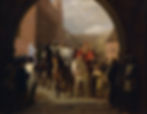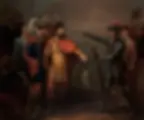Teutonic Knights: Origins, Crusades, and Legacy of the Medieval Order
- Davit Grigoryan
- Jun 29, 2024
- 11 min read
Updated: Aug 13
Imagine a grim medieval warrior clad in a snow-white cloak, marked by a stark black cross. This powerful visual symbol is instantly recognizable and inseparably tied to one of the most influential and enigmatic military-religious orders in history — the Teutonic Knights.
Their story begins as a modest brotherhood caring for sick pilgrims in the besieged crusader city of Acre at the end of the 12th century. From these humble origins, they rose to become a formidable force that shaped the fate of Northern Europe. It is a history woven from faith, the sword, and relentless expansion.

Recognized by the Pope in 1198 as a full-fledged military order, the Teutonic Knights initially served alongside the Templars and Hospitallers in the Holy Land. Yet their true fame and power came when they turned the edge of their mission toward the pagan lands of the Baltic. There, they waged brutal crusades, established their monastic state, and for centuries played a pivotal role in the region’s politics. Their legacy endures not only in the ruins of grand castles but also in the deep and complex mark they left on the history of Central and Eastern Europe.
These facts about the Teutonic Knights only open the door to their epic and intricate saga.
Origins and Foundation of the Teutonic Order
The roots of the Teutonic Order lie not in the fields of battle, but in the mercy and desperation of the Holy Land at the end of the 12th century. The Third Crusade (1189–1192) had turned the coastal cities of the Levant, especially Acre, into a vast melting pot of peoples, faiths, and blood. It was here, in a besieged city that the Crusaders desperately sought to wrest from Saladin, that a humble brotherhood was born.
It was founded by German merchants from Lübeck and Bremen, deeply moved by the suffering of their compatriots. Many German pilgrims and soldiers, wounded in battle or weakened by disease, found themselves in an unfamiliar environment dominated by French and Italian orders, often receiving inadequate care due to language barriers and cultural differences.

The answer to this tragedy came in 1190, with the creation of a field hospital — at first nothing more than a tent stretched over the masts of ships anchored in Acre’s harbor — to aid sick and wounded Germans.
This hospital community, operating under the patronage of the Church of St. Mary of Jerusalem, became the prototype for the future powerful order. Its rule was likely similar to that of the Hospitallers, emphasizing care for the suffering.
However, the harsh reality of the Crusades demanded more. Defending the Christian holdings required not only healers but warriors as well.
In 1198, when the Crusaders’ position in the Levant remained precarious, a decisive transformation took place. At the initiative of influential German princes and knights participating in the campaign, Pope Innocent III granted the brotherhood official status as a military-monastic order, modeled after the already renowned Templars and Hospitallers.
This event is considered the founding moment of the Teutonic Order as it is classically understood.
The new rule, approved by the Pope, combined monastic vows of poverty, chastity, and obedience with the warrior’s duty to defend the faith and fight the unbelievers. The order was granted the right to wear a distinctive white mantle emblazoned with a black cross — a symbol that soon struck fear into their enemies.
The history of the Teutonic Order as a military force began here, in Palestine. The first Grand Masters came from noble German families. The knights actively engaged in defending the remnants of the Kingdom of Jerusalem, participating in the construction and defense of castles, and skirmishing with Muslim forces.
They operated alongside the Templars and Hospitallers, adopting their experience but quickly developing their own identity and a special reputation among the German knighthood. Even in these early years, the order displayed distinctive traits: strict discipline, effective organization, and pragmatism. These qualities allowed it not only to survive the fall of Acre in 1291 but also to find a new and grand mission in Northern Europe.
Thus, the roots of the Teutonic Knights lie in mercy toward suffering compatriots, but their path to power was paved with the sword and the papal bull that transformed the brotherhood of hospitalers into a brotherhood of knights.
Crusades in the Baltic and the Northern Expansion
Although the roots of the Teutonic Order lay in the Holy Land, its true greatness and unique historical role were forged on the cold plains and in the dense forests of the Baltic region.
The early 13th century marked a turning point. The loss of Jerusalem in 1187 and growing Muslim pressure made the Crusaders’ position in the Middle East increasingly precarious.
Seeking a new mission and lands to assert their power, the Teutonic Knights turned their gaze northeastward, toward the pagan tribes of the Prussians, Lithuanians, Curonians, and Latgalians, who still worshipped ancient gods.

The idea of Christianizing these peoples by force found strong support from the papal throne, which saw it as a continuation of the holy mission of the Cross, and from German feudal lords eager to expand their territories — a movement known as the “Drang nach Osten,” or “Drive to the East.”
The decisive catalyst for the Teutonic Knights’ arrival in the region was the invitation from Polish Duke Konrad of Masovia in 1226.
Seeking to secure his northern borders from the devastating raids of the warlike Prussians, Konrad offered the order the lands of Chełmno (Kulmerland) in exchange for protection and the conquest of the pagans.
The Teutonic Knights, who already had some limited experience in Transylvania (where they were soon asked to leave), enthusiastically accepted the offer.
Emperor Frederick II granted the order a Golden Bull in Rimini (1226), and Pope Gregory IX followed with the “Golden Bull of Riga” (1234). These decrees bestowed not only lands to conquer but also unprecedented rights: supreme authority over the future territories, exemption from secular jurisdiction, and the right to mint their coins.
Thus began the epochal Prussian Crusade, a campaign that would stretch over half a century.
The campaigns of the Teutonic Knights in Prussia were long and incredibly brutal. The order’s forces, reinforced by waves of secular crusaders—including noble knights from across Europe drawn by promises of absolution—systematically crushed the resistance of the Prussian tribes.
Ancient sacred groves were cut down, fortified Prussian strongholds were stormed or besieged, and those who resisted were either exterminated or reduced to serfdom. On the sites of burned villages and shrines, the Teutonic Order’s imposing red-brick castles arose—strongholds of power and centers of centralized administration.

These fortresses, such as Marienburg (Malbork), which later became the order’s capital, Königsberg (Kaliningrad), and Ragnit (Neman), formed a network controlling the conquered lands. By the end of the 13th century, Prussian resistance had been largely broken, although uprisings—most notably between 1260 and 1274—continued to flare up from time to time.
German colonists settled on the seized territories, laying the foundation for a new society. The result of this grand expansion was the creation of a unique political entity — the Monastic State of the Teutonic Order (Ordensstaat), stretching from Pomerania to the borders of Novgorod lands.
This theocratic knightly enclave, governed by the Grand Master and the Chapter, became a powerful military machine and a significant player on the map of medieval Europe. The Teutonic Crusades in the Baltic forever altered the ethnic, religious, and political landscape of the region, laying the foundations for the future state of Prussia.
Famous Battles and Military Campaigns
The military might of the Teutonic Order was not a myth but a harsh reality, tested in dozens of battles across various theaters of war.
While their early feats in Palestine—such as defending the castles of Montfort and participating in the Battle of Azzaz in 1235—were significant, the true proving ground for refining their strategy and tactics was the vast expanse of Eastern Europe.
The conquest of Prussia itself was a series of countless skirmishes, sieges, and punitive expeditions where the knights demonstrated iron discipline and skillful use of the terrain. Their favored tactic was the famous “boar’s head” (or “hog’s head”)—a deeply echeloned wedge formation of heavily armored mounted knights capable of breaking through the lines of less organized opponents.
The armor of the Teutonic Knights evolved alongside military technology: from early chainmail and scale armor to the full plate armor (“white armor”) of the 15th century, which transformed a mounted knight into an almost impregnable fortress on horseback.
Their main weapons included a shield bearing the black cross, a large sword—often two-handed for fighting on foot—and a heavy lance.
However, the order faced challenges not only from the Prussian and Lithuanian tribes.
As its power and territorial ambitions grew, the Teutonic Knights’ conflicts with Poland and Lithuania became a recurring theme in regional politics. Disputes flared constantly—over contested lands like Pomerania and Samogitia, rivalries for influence, and the very practice of “raids” or crusades into pagan Lithuania, which often infringed upon the interests of already Christianized neighbors.
Wars with the United Polish-Lithuanian state reached their peak in the early 15th century.
The climax of this confrontation came at the grand Battle of Grunwald (also known as Tannenberg) on July 15, 1410. It was one of the largest battles of medieval Europe.
Grand Master Ulrich von Jungingen led the order’s finest knights into battle, reinforced by mercenaries and guest knights from Western Europe.
They faced a combined army led by Polish King Władysław II Jagiełło and Grand Duke Vytautas of Lithuania, which included Lithuanian, Ruthenian, Tatar, and Czech mercenary troops under the command of Jan Žižka.

The indomitable “boar’s head” formation of the Teutonic Knights initially crushed the Lithuanian banners, but in their eagerness to pursue the fleeing enemy, they fell under a flanking attack from the Polish reserves and became encircled.
A brutal melee ensued, where the numerical superiority of the allied forces and their greater tactical flexibility proved decisive. The order suffered a devastating defeat.
The battlefield was strewn with the bodies of thousands of knights, including the Grand Master himself and nearly the entire senior command.
Although the order managed to hold its capital, Marienburg, thanks to the heroic defense led by Heinrich von Plauen, Grunwald marked a turning point in the history of the Teutonic Order.
This catastrophe shattered its military reputation, drained its treasury through huge ransom payments for prisoners, and cost it its best commanders, beginning the irreversible decline of the once-formidable Ordensstaat’s military and political power.
After Grunwald, the Teutonic Order’s battles increasingly became defensive and ended more often with territorial concessions.
Decline and Secularization
The disaster at Grunwald in 1410 was not merely a military defeat but a severe trauma from which the Teutonic Order never fully recovered its former strength.
Although Marienburg held firm, the cost of survival was unbearably high. The decline of the Teutonic Order became an irreversible process, undermined by several factors at once.
The order’s financial system collapsed under the burden of enormous ransom payments for captured knights and the devastation of its lands. To cover debts, taxes were raised, sparking unrest and rebellions in cities and among the local nobility who had previously been loyal to the order.

The military elite was decimated at Grunwald, and new generations of commanders lacked both the authority and talent of their predecessors.
External political pressure intensified: the victorious Polish-Lithuanian Commonwealth methodically reclaimed disputed territories—such as Dobrzyń Land under the First Treaty of Toruń in 1411 and Samogitia by the Treaty of Melno in 1422.
Within the Ordensstaat itself, dissatisfaction grew among the secular estates—townspeople and local vassal knights—who desired greater rights and participation in governance but were met with the order’s conservative theocratic structure.
The Thirteen Years’ War (1454–1466), which began with a rebellion by the Prussian Confederation of cities and nobles against the order’s rule, finally shattered its power.
By the Second Treaty of Toruń in 1466, the order lost nearly half its territory, including its capital Marienburg and Gdańsk (Danzig), and acknowledged itself a vassal of the Polish crown in the remaining part of Prussia.
The final act in the drama of the medieval military order unfolded under the influence of the Reformation.
When Luther’s ideas spread into Prussia, they found fertile ground among the local nobility and townspeople, who had grown weary of the rule of foreign warrior-monks and the burdens of church taxes.
Grand Master Albrecht of Brandenburg-Ansbach, a member of the powerful Hohenzollern dynasty, faced a critical choice. Recognizing the futility of continued resistance against Poland and the internal instability of the order, he embraced Lutheranism.
In 1525, in Kraków, after swearing fealty to Polish King Sigismund I the Old, Albrecht carried out an unprecedented act: the secularization of the Teutonic Order in Prussia became a fait accompli.
The monastic state was transformed into the secular Duchy of Prussia, the first Protestant state in Europe, with Albrecht and his descendants as hereditary rulers.
This marked the end of the Ordensstaat in its former form. Although some bailiwicks (provinces) of the order within the Holy Roman Empire—especially in southern Germany—persisted as Catholic religious and charitable institutions, abandoning their military role, their former power faded into oblivion.
The history of the Duchy of Prussia, which would become the core of the future Kingdom of Prussia and the German Empire, began with this act of the Grand Master’s renunciation of his vows and office.
Legacy and Cultural Impact of Teutonic Knights
The history of the Teutonic Order came to an end with the secularization of its main state, yet its ghost continued to roam Europe, leaving a deep and ambiguous legacy.
The legacy of the Teutonic Knights is multifaceted and extends far beyond their military campaigns. Perhaps the most visible and impressive testament to their presence is their majestic castles.
Built in the distinctive style of Brick Gothic, these impregnable fortresses scattered across what is now Poland, Russia’s Kaliningrad region, and the Baltic countries still capture the imagination today.

Marienburg (Malbork)—the largest brick castle in the world and the former capital of the order—stands as a symbol of their power and organizational genius.
Castles in Königsberg (the Royal Castle, now lost), Toruń, Gniew, and Balga served not only as military bases but also as centers of administration, economy (monastic estates), and culture.
Together, they created a unique architectural landscape in Northeast Europe and remain important tourist attractions to this day.
Politically, the Order became a cornerstone in the history of Prussia. The state it had founded, later transformed into the secular Duchy of Prussia under the Hohenzollerns, evolved into the core of the powerful Kingdom of Prussia and, eventually, the unified German Empire in 1871. The so-called “Prussian” virtues—discipline, order, and a sense of military duty—were often traced (and at times mythologized) back to the spirit of the Teutonic Knights, especially during the nationalist fervor of the 19th century.
However, the influence of the Teutonic Order extended far beyond Germany. Its aggressive expansion and conflicts with Poland and Lithuania left a lasting imprint on the historical memory and national narratives of those nations, often casting the figure of the knight in the black-and-white mantle in a dark light—as a symbol of foreign domination and threat. A vivid example of this portrayal can be found in Polish literature and cinema, such as Henryk Sienkiewicz’s The Knights of the Cross and Aleksander Ford’s film adaptation of the same name.
The cultural myth of the Teutonic Knight proved remarkably enduring. In the 19th century, German Romanticists idealized them as noble warrior-missionaries bringing the light of civilization to the wild East. This romanticized image, later embraced by Nazi propaganda, distorted historical reality and gave rise to dangerous pseudo-historical myths.
At the same time, the figure of the disciplined, fanatical, and ruthless warrior-monk became firmly entrenched in popular culture—from video games such as Stronghold and Crusader Kings to historical novels and films.

The modern Teutonic Order, reestablished in Austria in the 19th century as a Catholic spiritual and charitable institution (officially recognized by the Vatican), remains active today, focusing on humanitarian work and preserving historical memory, though it no longer wields any military or political power.
Their castles, myths, and true history serve as a lasting reminder of the complex interplay between faith and violence, colonization and cultural exchange, the chivalric ideal and harsh political pragmatism—forces that shaped the medieval Baltic world and left behind ruins and legends that continue to capture the imagination to this day.